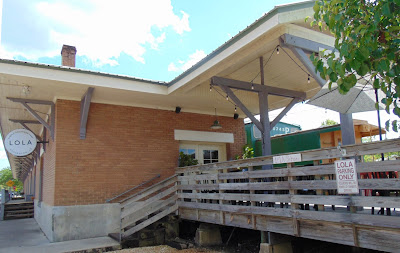South side
A
timeline of important dates in the development of the railroad in St.
Tammany Parish is detailed in the book "The Early History of Bonfouca
and Lake Pontchartrain" by Carl Fedrowisch. On Dan Ellis' website the following information is provided:
The Mandeville to Sulphur Springs Railroad Co. was organized in 1868, aiming to build a railroad from Mandeville northward towards Abita Springs.
A 22 mile long railroad trestle between New Orleans and Mandeville was deemed "possible" by engineers in 1880, but a year later the proposed bridge location was moved to the east end of the lake following the completion of the preliminary survey.
On October 15, 1883, the railroad bridge across Lake Pontchartrain south of Slidell was completed. The first train arrived in New Orleans from Meridian, MS, and Slidell became an important railroad stop, especially with the coming of the creosoting process and Roberts Landing creosote plant providing trestle building timbers and crossties that lasted much longer in service.
In June of 1887, the East Louisiana Railroad was completed between Pearl River and Abita Springs, and on May 16, 1888, the East Louisiana Railroad was completed into Covington.
In 1904, the New Orleans and Great Northern Railroad was organized and plans were made to build a track from New Orleans to Bogalusa, then northward up the west side of the Pearl River to Jackson, MS. The same year the Salmen brothers of Slidell started building a railroad track from Slidell to Mandeville.
The original railroad depot in Covington was built in mid-1888, and when the East Louisiana Railroad reached Covington, it heralded an economic boom. The original depot faced New Hampshire Street with a passenger and freight terminal facing east. The track split in front of what is now Hebert's Cleaners, with one track curving northward towards New Hampshire St. and the other track continuing on Gibson heading west.
The Mandeville to Sulphur Springs Railroad Co. was organized in 1868, aiming to build a railroad from Mandeville northward towards Abita Springs.
A 22 mile long railroad trestle between New Orleans and Mandeville was deemed "possible" by engineers in 1880, but a year later the proposed bridge location was moved to the east end of the lake following the completion of the preliminary survey.
On October 15, 1883, the railroad bridge across Lake Pontchartrain south of Slidell was completed. The first train arrived in New Orleans from Meridian, MS, and Slidell became an important railroad stop, especially with the coming of the creosoting process and Roberts Landing creosote plant providing trestle building timbers and crossties that lasted much longer in service.
In June of 1887, the East Louisiana Railroad was completed between Pearl River and Abita Springs, and on May 16, 1888, the East Louisiana Railroad was completed into Covington.
In 1904, the New Orleans and Great Northern Railroad was organized and plans were made to build a track from New Orleans to Bogalusa, then northward up the west side of the Pearl River to Jackson, MS. The same year the Salmen brothers of Slidell started building a railroad track from Slidell to Mandeville.
The original railroad depot in Covington was built in mid-1888, and when the East Louisiana Railroad reached Covington, it heralded an economic boom. The original depot faced New Hampshire Street with a passenger and freight terminal facing east. The track split in front of what is now Hebert's Cleaners, with one track curving northward towards New Hampshire St. and the other track continuing on Gibson heading west.
Eventually
the increase in the volume of train traffic convinced town officials
and business people that a bigger, better train depot was needed, and
the push for a new train station began.
The new depot would be on N. New Hampshire a block north of the existing depot.
1982
The Depot in 2019
The north end of the train depot building is occupied by Lola Restaurant.
The Lola kitchen is located in an old train caboose.
An old passenger car was recently brought in to serve as a future dining area.
The car is currently undergoing renovation.
Interior of future dining car
Curved wooden ceiling of old passenger car













































